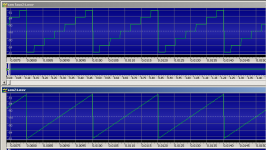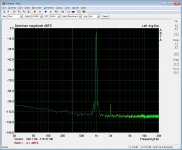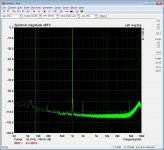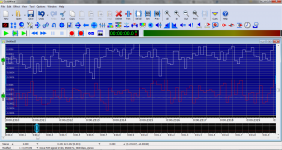edit: NM, I think I found it. Sheesh.
I was told this works and is free Wavosaur free audio editor with VST and ASIO support.
Thanks Scott! You are the A number 1 number cruncher. 
I took a cruder approach. Below you'll see two 500Hz sawtooth waves. Both are in a 24 bit wrapper, but the top wave is only 16 bit resolution. Easy to see at this extremely low level. Peak value is -80dB FS.

I took a cruder approach. Below you'll see two 500Hz sawtooth waves. Both are in a 24 bit wrapper, but the top wave is only 16 bit resolution. Easy to see at this extremely low level. Peak value is -80dB FS.
Attachments
I was told this works and is free Wavosaur free audio editor with VST and ASIO support.
Seems to be abandoned SW, Nike shoe sales seems to be the thing for the moment.
To bad that this is the trend - promissing software dies. Worse is that it doesn't get into open software before it dies to become an community effort!
Regards
Just be sure to use the ASIO driver. I had to open ARTA select the ASIO driver and without resetting anything it was 24bit in Audition or CoolEdit. That app says ASIO is built in.Excellent, I'll try it.
Seems to be abandoned SW, Nike shoe sales seems to be the thing for the moment.
Regards
That's too bad but there are downloads for the last versions. I refuse to learn how to drive/payfor a DAW app just to transfer LP's.
Fair enough Scott. This thread is about audio analysis so the demand is different. I wouldn't like to see that my software suddenly died - another example is the Visual Analyzer where the development and any sign of the developer suddenly was lost in 2014. I do not understand why ones work shouldn't live beyond ones ego...
GPL your code and live forever 🙂
Regards
GPL your code and live forever 🙂
Regards
Thanks Scott! You are the A number 1 number cruncher.
I took a cruder approach. Below you'll see two 500Hz sawtooth waves. Both are in a 24 bit wrapper, but the top wave is only 16 bit resolution. Easy to see at this extremely low level. Peak value is -80dB FS.
Is this due to software signal generation or the hardware?
Could not find the EMU 0404 data. Perhaps it is buried somewhere?It was created by the conference software behind my back.
But, since you mentioned a link, a working one can be contrived by hand:
https://web.archive.org/web/20070303180526/http://www.pcavtech.com/
The highest sample rate and bit depth test on the EMU 0404 USB I found is here.
http://www.dearhoney.idv.tw/SoundCard/EMU0404USB/E-MU0404USB_96K_Out.htm
Last edited:
Could not find the EMU 0404 data. Perhaps it is buried somewhere?
The highest sample rate and bit depth test on the EMU 0404 USB I found is here.
RightMark Audio Analyzer test: E-MU 0404 USB 96K Out
Be careful, it can be hard to interpret FFT's because you have to know the FFT length and the window used to interpret the noise floor.
Could you explain this further. I have an MAudio PCI card that seems to measure very well, more so than what I would expect, and I wonder if it's a bit of lie.
Well, I am only worried about full duplex bandwidth as the first requirement. No external power requirement for 24bit/96KHz full duplex, if the device runs on external power, then it has to do 24bit/192KHz full duplex. Currently I have not seen any device that meets these criteria. Well, at least not small and simple.Be careful, it can be hard to interpret FFT's because you have to know the FFT length and the window used to interpret the noise floor.
Last edited:
Here I just tried the Xonar U5 at 24/192 line-in patched to headphone out on ARTA. You can get different/better results with speaker out all look pretty decent in general.
Attachments
Last edited:
Could you explain this further. I have an MAudio PCI card that seems to measure very well, more so than what I would expect, and I wonder if it's a bit of lie.
Let's say you're looping a pure sinusoid through your system. You will *get* the fundamental, any non-linearitities (harmonics) and noise.
Noise will have a spectrum. If you run the loop for a long, long, long, LONG time, the accumulation of the consistent signal will be linear, whereas the noise will be distributed over the frequency spectrum, essentially, you're time averaging the noise out. Depending on the noise distribution, if N is the rate of accumulation in your signal, sqrt(N) will be the rate of your noise accumulation. This adds up pretty quick.
Total noise energy will be captured by a super-long FFT, but the bins get finer and finer (i.e the noise is distributed over more and more bins but the signal remains in only one bin the whole time)
Last edited:
Let's say you're looping a pure sinusoid through your system. You will the fundamental, any non-linearitities (harmonics) and noise.
Noise will have a spectrum. If you run the loop for a long, long, long, LONG time, the accumulation of the consistent signal will be linear, whereas the noise will be distributed over the frequency spectrum, essentially, you're time averaging the noise out. Depending on the noise distribution, if N is the rate of accumulation in your signal, sqrt(N) will be the rate of your noise accumulation. This adds up pretty quick.
Total noise energy will be captured by a super-long FFT, but the bins get finer and finer (i.e the noise is distributed over more and more bins but the signal remains in only one bin the whole time)
Yes, did you know there is actually a "famous" person named Revilo P. Oliver.
Don't really understand what you are trying to do. 1KHz distortion? Bandwidth does not show the 192KHz sample rate bandwidth. I normally to loop back frequency response testing to confirm the bandwidth.Here I just tried the Xonar U5 at 24/192 line-in patched to headphone out on ARTA.
One Soundblaster PCMCIA card I tested would not get the phase right unless I shifted the input sampling by 0.01041 ms in one channel. This indicated that two channels were running interleaved between each other. I used SoundEasy to do the measurements in order to figure out the necessary calibration; single channel send the output MLS output, two channels read the input. I do not consider this a true full duplex operation.
Last edited:
Yes, did you know there is actually a "famous" person named Revilo P. Oliver.
Hahaha, no! Learn something new every day. Weird parents! I can't remember the exact details, but my username traces back to childhood exchanges with my older brother (I thought it was a form of "endearment", but not really sure).
I probably should put in my signature that my real name is Daniel to stop the confusion. 🙂
Don't really understand what you are trying to do. 1KHz distortion? Bandwidth does not show the 192KHz sample rate bandwidth. I normally to loop back frequency response testing to confirm the bandwidth.
One Soundblaster PCMCIA card I tested would not get the phase right unless I shifted the input sampling by 0.01041 ms in one channel. This indicated that two channels were running interleaved between each other. I used SoundEasy to do the measurements in order to figure out the necessary calibration; single channel send the output MLS output, two channels read the input. I do not consider this a true full duplex operation.
OK, one has to drill down into the bits for these things but this card seems to be doing what it says. I just showed 20-20k
Attachments
- Status
- Not open for further replies.
- Home
- Design & Build
- Equipment & Tools
- USB sound card for audio spectrum analysis



